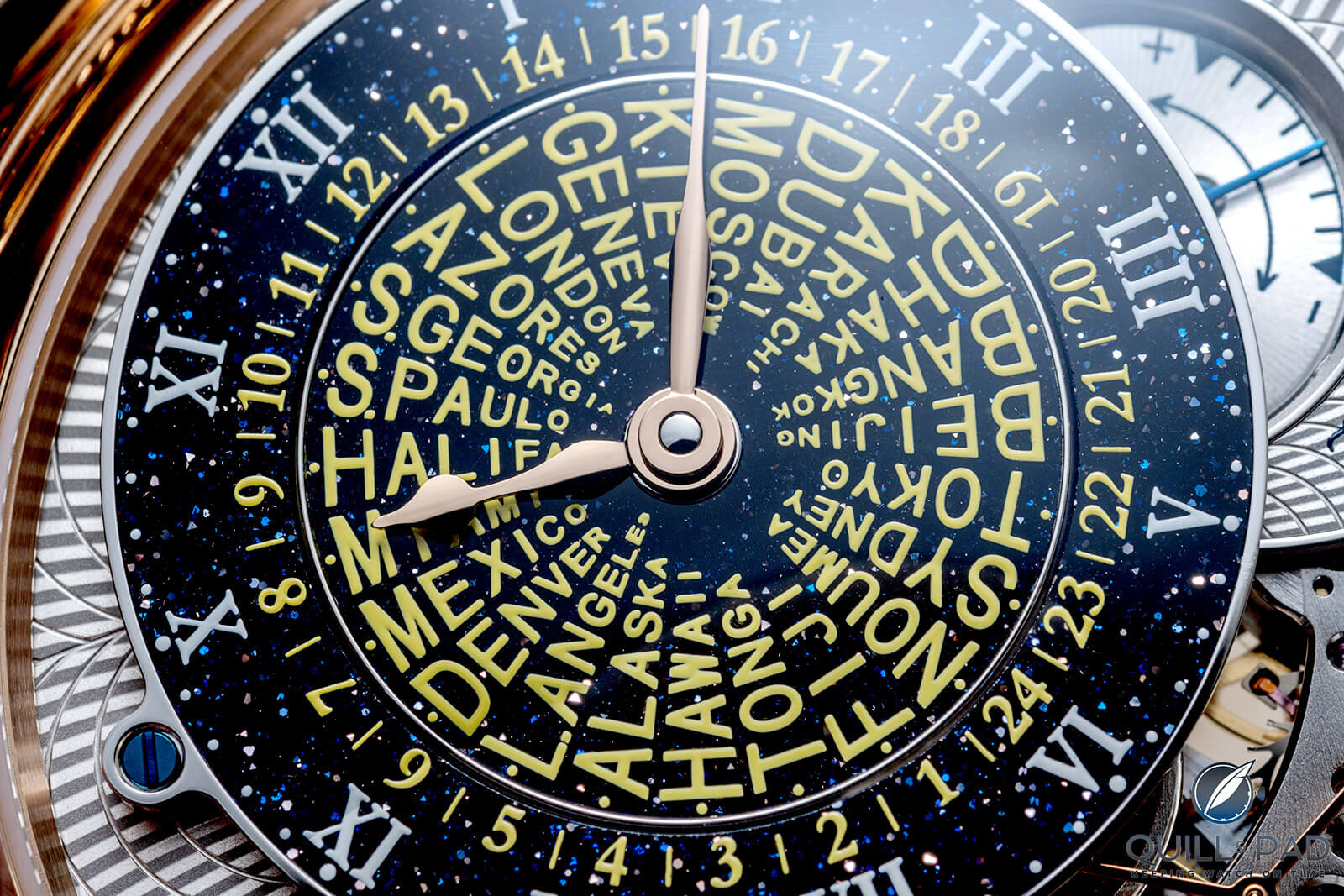by Martin Green
Bovet has always been a brand with a particular fondness for watches that show multiple time zones. Its founders were conspicuous world travelers, notably bringing Swiss watchmaking to China, and I suspect that much of Bovet’s current clientele also travels the globe with some regularity.
I always appreciate the Bovet models with multiple time zones because these complications are integrated so effortlessly. The new Orbis Mundi, created to celebrate the brand’s 200th anniversary, is no exception.

Bovet Orbis Mundi
Bovet Orbis Mundi at a glance
The Bovet Orbis Mundi is dominated by the hours and minutes in the middle. But even more so by the aventurine disk displaying world time on 24 time zones as the base for an eye-catching design underneath the hands.

Bovet Orbis Mundi
This display is brilliant in all its simplicity as it can be read with ease at a glance. Setting the watch is equally easy as turning the crown in one direction changes the local time, while turning it in the other direction sets the world time.

Bovet Orbis Mundi worldtime dial
The choice of yellow font and numbers might be surprising, but it works very well, giving the watch a certain playfulness while also increasing legibility: a win-win situation.

Bovet Orbis Mundi three-handed second display
The power reserve is subtly shown on the right side of the dial, peeking out from behind the aventurine disk, while below it part of the gear train is visible. At 6 o’clock the “three-handed” seconds are indicated on an aventurine arc. It is one of those things that makes the Orbis Mundi such a delightful watch: all of its details are so thought through, especially in relation to each other.
Bovet Orbis Mundi: a case for traveling
I have always been a fan of Bovet’s Fleurier case. The design of the top lugs is a nod to the brand’s past in pocket watches, but it also plays a vital role in the wearing comfort of the Orbis Mundi. Most importantly the case adds a great deal of character as no other wristwatch on the market looks like this.

Bovet Orbis Mundi
With a diameter of 42 mm, the Orbis Mundi is substantially sized and looks even larger as the bezel is relatively slim. That is good news because it provides enough room for the dial to shine while maintaining a very high degree of legibility.
With a height of 11.25 mm the Orbis Mundi is remarkably thin. This is another area in which Bovet excels as the brand’s movements are not only excellent, the thickness is always kept in check. They look more sculpted than anything else.

Beautifully finished Caliber 15BM01HU, visible through the display back of the Bovet Orbis Mundi
Caliber 15BM01HU is a manual-wind movement that offers a generous power reserve of a full week. Bovet achieves this using just a single spring barrel. The finishing is of very high quality as can be expected of a brand positioned like Bovet, and combined with the layout of the movement it makes the back of the watch equally as beautiful as the front.
Bovet offers the Orbis Mundi in either red gold or titanium and I find it difficult to choose between them. The watch looks so good in gold with its warm hue pleasantly contrasting with the dial, but titanium makes more sense, keeping the Orbis Mundi very light and making it a more practical and less formal globetrotter.

Bovet Orbis Mundi
For those with deep pockets, having both might also be an option as the different metals have quite an impact on the looks of the Orbis Mundi.
The bottom line is that with the Orbis Mundi Bovet shows once more that beauty and practicality can go seemingly effortlessly hand in hand and travel the world together.
For more information, please visit www.bovet.com/Timepiece/orbis-mundi.
Quick Facts Bovet Orbis Mundi
Case: 42 x 11.25 mm, titanium or red gold, 30-meter water resistance
Movement: hand-wound Caliber 15BM01HU with seven-day power reserve and one single spring barrel, 3 Hz/21,600 vph frequency
Functions: hours, minutes, seconds; world time; power reserve indication
Limitation: 60 pieces in each metal
Price: CHF 46,000 (red gold); CHF 40,700 (titanium)
You may also enjoy:
The Bovet 19thirty UAE Anniversary Edition With Ahmed Seddiqi & Sons
Pininfarina Hyper GT Inspires Bovet Battista Tourbillon: It’s Electrifying!
Leave a Reply
Want to join the discussion?Feel free to contribute!





















































Muy raro el uso de titanio en un reloj de este tipo. Me gustaria saber como los genios de Bovet resolvieron el mantener la precisión al final del viento.